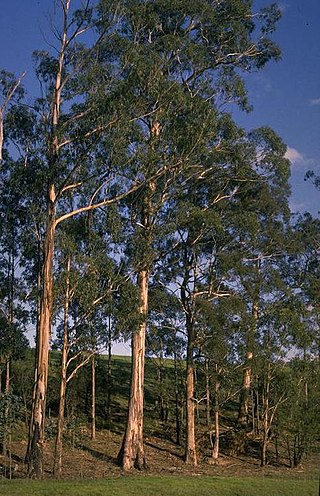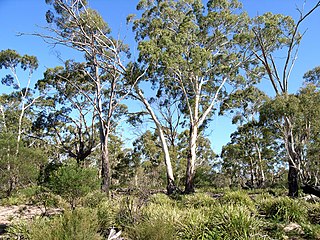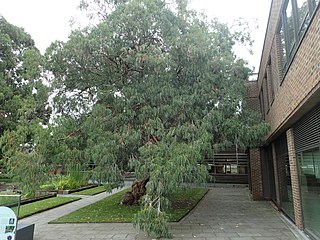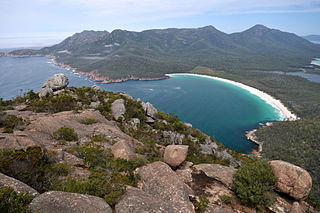
Eucalyptus is a genus of more than 700 species of flowering plants in the family Myrtaceae. Most species of Eucalyptus are trees, often mallees, and a few are shrubs. Along with several other genera in the tribe Eucalypteae, including Corymbia and Angophora, they are commonly known as eucalypts. Plants in the genus Eucalyptus have bark that is either smooth, fibrous, hard or stringy, the leaves have oil glands, and the sepals and petals are fused to form a "cap" or operculum over the stamens. The fruit is a woody capsule commonly referred to as a "gumnut".

The South Bruny National Park is a national park located on Bruny Island, Tasmania, Australia, about 50 kilometres (31 mi) south of Hobart. The park contains the Cape Bruny Lighthouse. The highest point of the park is Mount Bruny at 504 metres (1,654 ft).

Eucalyptus regnans, known variously as mountain ash, swamp gum, or stringy gum, is a species of medium-sized to very tall forest tree that is native to the Australia states of Tasmania and Victoria. It is a straight-trunked tree with smooth grey bark, but with a stocking of rough brown bark at the base, glossy green, lance-shaped to curved adult leaves, flower buds in groups of between nine and fifteen, white flowers, and cup-shaped or conical fruit. It is the tallest of all flowering plants; the tallest measured living specimen, named Centurion, stands 100 metres tall in Tasmania.

Eucalyptus pauciflora, commonly known as snow gum, cabbage gum or white sally, is a species of tree or mallee that is native to eastern Australia. It has smooth bark, lance-shaped to elliptical leaves, flower buds in clusters of between seven and fifteen, white flowers and cup-shaped, conical or hemispherical fruit. It is widespread and locally common in woodland in cold sites above 700 m (2,300 ft) altitude.

Eucalyptus globulus, commonly known as southern blue gum or blue gum, is a species of flowering plant in the family Myrtaceae. It is a tall, evergreen tree endemic to southeastern Australia. This Eucalyptus species has mostly smooth bark, juvenile leaves that are whitish and waxy on the lower surface, glossy green, lance-shaped adult leaves, glaucous, ribbed flower buds arranged singly or in groups of three or seven in leaf axils, white flowers and woody fruit.

Eucalyptus viminalis, commonly known as the manna gum, white gum or ribbon gum, is a species of small to very tall tree that is endemic to south-eastern Australia. It has smooth bark, sometimes with rough bark near the base, lance-shaped to curved adult leaves, flower buds in groups of three or seven, white flowers and cup-shaped or hemispherical fruit.

Eucalyptus gunnii, commonly known as cider gum, is a species of large tree in the flowering plant family Myrtaceae. It is endemic to the island of Tasmania, Australia. It has mostly smooth bark, lance-shaped to egg-shaped adult leaves, flower buds in groups of three, white flowers and cylindrical to barrel-shaped fruit.

Eucalyptus morrisbyi, commonly known as Morrisby's gum, is a species of small to medium-sized tree that is endemic to a restricted area of Tasmania. It has loose slabs of rough bark near the base of its trunk, smooth pale grey bark above, lance-shaped to egg-shaped adult leaves, flower buds in groups of three, white flowers and barrel-shaped or cylindrical fruit. It is only known in the wild from a few small populations but has been widely planted as an ornamental.

Eucalyptus cordata, commonly known as the heart-leaved silver gum is a shrub to medium-sized tree that is endemic to Tasmania. It has smooth bark throughout, mostly only juvenile, more or less heart-shaped, glaucous leaves, glaucous flower buds arranged in groups of three, white flowers and cylindrical or hemispherical fruit.

Eucalyptus perriniana, commonly known as spinning gum, is a tree or mallee which is native to New South Wales, the Australian Capital Territory, Victoria and Tasmania. Spinning gum is a sub-alpine species and grows in areas which are normally snow covered for several months in winter. However domestic cultivars can grow in almost any temperate climate.

Eucalyptus coccifera, commonly known as the Tasmanian snow gum, is a small to medium-sized tree endemic to Tasmania. It has smooth, grey and cream-coloured bark, elliptic to lance-shaped adult leaves, flower buds in groups of between three and nine, usually white flowers and conical, hemispherical or cup-shaped fruit.

Persoonia muelleri, commonly known as Mueller’s geebung, is a shrub endemic to Tasmania. It forms a shrub in open areas of wet forests in the west and northeast of the state. It is occasionally confused with P. gunnii though it has larger flowers and longer, straighter leaves.

Eucalyptus archeri, also known as alpine cider gum, is a mallee or a small tree that is endemic to Tasmania. It has smooth white or greyish bark, lance-shaped adult leaves, flower buds in groups of three, white flowers and conical to barrel-shaped fruit. It intergrades with E. gunnii.

Eucalyptus pulchella, commonly known as the white peppermint or narrow-leaved peppermint, is a species of small to medium-sized tree that is endemic to Tasmania. it has smooth bark, sometimes with rough fibrous bark on older trees, linear leaves, flower buds in groups of nine to twenty or more, white flowers and cup-shaped to shortened spherical fruit.
The Peter Murrell Conservation Area is located in Huntingfield, Tasmania, approximately 15 km (9.3 mi) south of the state's capital city, Hobart. The conservation area has an area of 135 ha and is one of three reserves within the Peter Murrell Reserves. Also within these reserves are the Peter Murrell State Reserve and a Public Reserve. These reserves and the Conservation Area lie at the base of the Tinderbox Peninsula, between the suburbs of Kingston, Howden and Blackman's Bay. The Peter Murrell Conservation Area surrounds the northern, western and southern sides of the Peter Murrell State Reserve.

Eucalyptus urnigera, commonly known as urn tree, is a species of small to medium-sized tree that is endemic to Tasmania. It has smooth bark, lance-shaped or elliptical leaves, flower buds in groups of three, white flowers and urn-shaped fruit.

Trochocarpa gunnii, commonly known as sweet-scented trochocarpa or fragrant purpleberry, is a common rainforest understorey shrub from the plant family Ericaceae endemic to Tasmania.

Eucalyptus globulus subsp. globulus, commonly known as the Tasmanian blue gum, southern blue gum, or blue gum, is a subspecies of tree that is endemic to southeastern Australia. It has mostly smooth bark with some persistent slabs of old bark at the base, juvenile leaves with one glaucous side, glossy, lance-shaped adult leaves, warty flower buds arranged singly in leaf axils, white flowers and hemispherical to conical fruit that is more or less square in cross-section.

The Tasmanian temperate forests is a temperate broadleaf and mixed forests ecoregion in Australia. The ecoregion occupies the eastern portion of the island of Tasmania, which lies south of the Australian mainland.


















